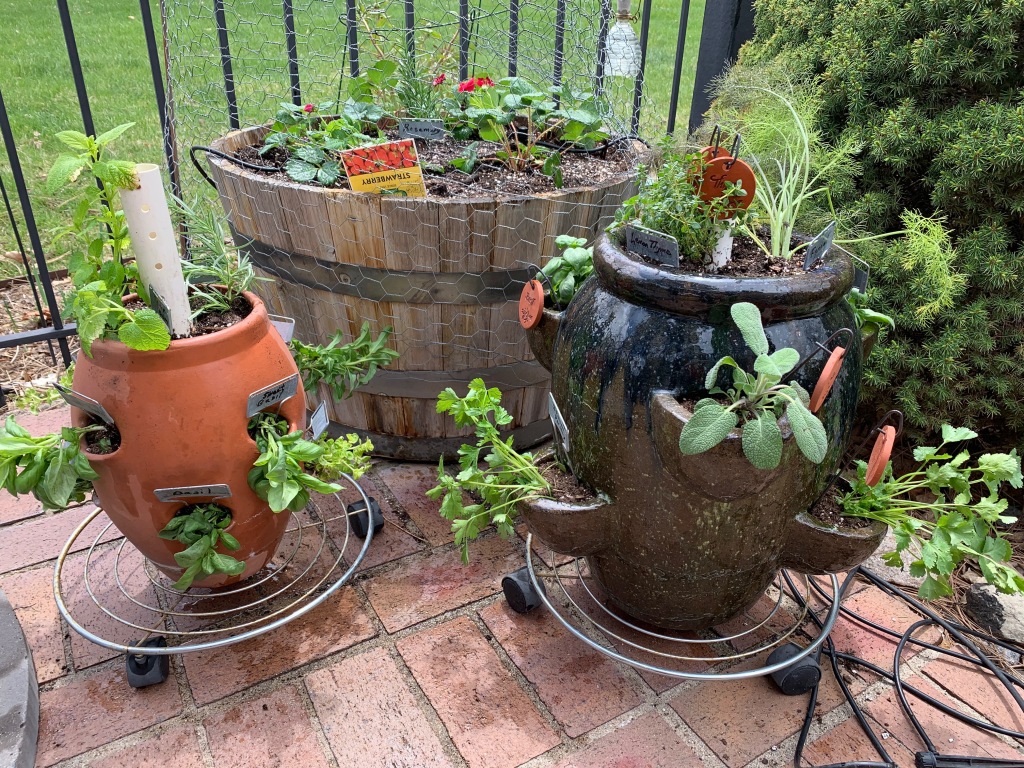By Felicia Brower, CSU Extension – Denver Master Gardener since 2020
Sensory gardens – gardens that appeal to one or more of the five senses – are a great way to get both children and adults excited about the natural world. Featuring plants that appeal to sight, smell, taste, sound, and touch turns a stroll through the garden into an immersive experience where you can engage with the grasses, trees, flowers, shrubs, and hardscape elements.
Sensory gardens can be any size and can be designed to target just one sense (a garden with exceptionally bright or fragrant flowers is a good example) or as many senses as possible. Some senses are easier to find plants for than others, which is where hardscape elements come in handy. Texture from boulders, walkway stones, stumps, woodchips, and other permanent structures can take away the need to touch the plants directly, though there are plants that make finger-friendly additions to the garden.
Always make sure that your sensory garden is safe for visitors. Avoid putting harmful plants within easy reach of pathways or using toxic pesticides on plants that are easily accessible, especially if your garden is geared towards younger, curious children.
Before you plant anything, check your location to make sure that you’re choosing plants that will thrive there. Putting plants with high water needs by those with low water needs can result in plants being over- or under-watered and not surviving. Make sure you accommodate for sun and shade needs as well.
If you want to give your sensory garden an added environmental bonus, make one with native plants! These localized plants are adapted for our climate, soil, and water needs and serve as important habitats and food sources to native birds and bugs.
Here are a few plants that would make a great addition to your Colorado sensory garden:
Sight
Plants that are brightly colored or with distinctly shaped flowers, seeds, or leaves draw the eye and can be a great source of excitement in the garden. Shrubs like serviceberry (Amelanchier alnifolia) are great multi-season additions to the garden, with clusters of small white flowers, blue-black berries, and an orange to red coloring in the fall. Mountain Mahogany (Cercocarpus montanus) has distinctly shaped, feathery corkscrew seed heads. The undersides of the leaves are furry, and the flowers have a sweet smell, which allows you to cross off three senses (sight, touch, and smell) with just one plant.
Sound
Ornamental grasses are an easy way to appeal to sound in your sensory garden. Big bluestem (Andropogon gerardii) is a native grass that grows as a 3-foot-tall arching clump of blue-green leaves in the summer. Flowering stalks emerge in late summer and grow as tall as six feet, and the seedheads that form resemble a turkey’s foot. Listening to the sound of the grass swaying in a late-summer breeze is a great way to unwind in the garden. As an added sight bonus, the leaves turn pink, orange, rust, and purple in the fall. Despite the name, Little bluestem (Schizachyrium scoparium) is a different plant entirely that also goes through beautiful color changes (powder blue, darkening to purple, and ending with dark red stalks in winter) and provides a nice soothing sound when it sways in the summer and fall winds.
Touch
As mentioned earlier, adding hardscape elements like stumps, boulders, smooth walkway stones, and woodchip paths is a simple way to add texture to your garden and check off the touch box in your sensory garden. There are some native plants that have textures as well, including the blanket flower (Gaillardia aristata) with its fuzzy leaves and stunning yellow and red daisy blooms and Blue Grama grass (Bouteloua gracilis) known informally as “eyelash grass” due to the shape of its seed clusters.
Smell
Smell is one of the easier senses to find plants for, as many flowers have fragrant blooms. A popular native plant that works well is aptly named chocolate flower (Berlandiera lyrata) with its chocolate smelling daisy-like flowers. Agastache sunset hyssop (Agastache rupestris), another native, appeals to both sight and smell with its vibrant spikes of orange and purple flowers that emit a root beer fragrance.
Taste
Always exercise caution when eating anything out of the garden. Make sure that you’ve correctly identified the plant and that it’s safe to consume before eating it or encouraging others to do the same. The golden currant (Ribes aureum) is a safe-to-eat shrub with sweet yellow, red, or black berries that emerge in the late-summer and fall. These berries can be eaten fresh off the plant or be used to make jams and jellies.
Sensory gardens add another layer to a garden. Whether you’re passing through quickly or spending more time in one to take it all in, you’ll feel more connected to the plants during your sensory experience.





































